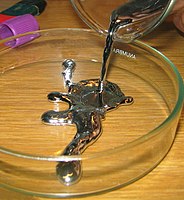
Photo from wikipedia
In the environment, nanomaterials (NMs) are subject to chemical transformations, such as redox reactions, dissolution, coating degradation, and organic matter, protein, and macromolecule binding, and physical transformations including homo or… Click to show full abstract
In the environment, nanomaterials (NMs) are subject to chemical transformations, such as redox reactions, dissolution, coating degradation, and organic matter, protein, and macromolecule binding, and physical transformations including homo or heteroagglomeration. The combination of these reactions can result in NMs with differing characteristics progressing through a functional fate pathway that leads to the formation of transformed NM functional fate groups with shared properties. To establish the nature of such effects of transformation on NMs, four main types of studies are conducted: 1) chemical aging for transformation of pristine NMs; 2) manipulation of test media to change NM surface properties; 3) aging of pristine NMs water, sediment, or soil; 4) NM aging in waste streams and natural environments. From these studies a paradigm of aging effects on NM uptake and toxicity can be developed. Transformation, especially speciation changes, largely results in reduced potency. Further reactions at the surface resulting in processes, such as ecocorona formation and heteroagglomeration may additionally reduce NM potency. When NMs of differing potency transform and enter environments, common transformation reaction occurring in receiving system may act to reduce the variation in hazard between different initial NMs leading to similar actual hazard under realistic exposure conditions.
Journal Title: Small
Year Published: 2020
Link to full text (if available)
Share on Social Media: Sign Up to like & get
recommendations!